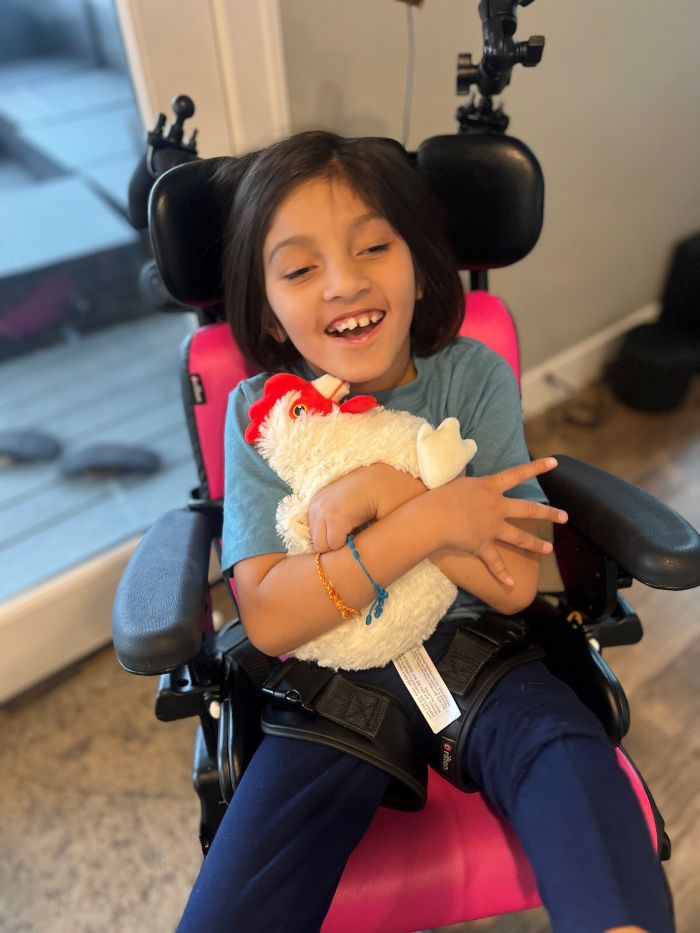Ten-year-old Hazel Kim, a patient at Gillette Children’s Complex Movement Disorders Clinic, displayed incredible resilience right from birth. “She came into the world under traumatic circumstances — born via emergency C-section after her heartbeat was lost during delivery,” shares Hazel’s mom, Lindsay. The Kims were informed that Hazel would likely be diagnosed with cerebral palsy as a result of her complicated birth. “From that moment on,” Lindsay says, “we made a promise to ourselves — and to Hazel — that we would do everything in our power to help her live life to the fullest.”
Hazel was ultimately diagnosed with quadriplegic cerebral palsy with mixed tone. After an initial appointment with Marshall Taniguchi, MD, physical medicine and rehabilitation physician, he encouraged the Kims to have Hazel evaluated by the experts at Gillette’s Complex Movement Disorders Clinic, where they met pediatric neurosurgeon Patrick Graupman, MD, and pediatric neurologist Timothy Feyma, MD. That’s when everything
changed, says Lindsay. “We started a transformative journey — including the decision to pursue a deep brain stimulation (DBS) implant. DBS has given [Hazel] the chance to gain more control over her movements and engage more fully with the world around her.”
DBS involves the percutaneous implantation of a neurostimulator in the abdomen or chest connected to a flexible lead implanted in the brain. The neurostimulator delivers continuous low-voltage electrical impulses to targeted areas of the brain that block or change the abnormally functioning neurons that cause uncontrolled movement, bringing relief to the patient. It is an excellent tool for managing complex movement disorders caused by an underlying condition — in Hazel’s case, uncontrolled movement related to her primary diagnosis of cerebral palsy. DBS is both adjustable and reversible.
Trusting Hazel and her family to participate in the care planning and adherence has never been a concern, says Timothy Feyma, MD. “Hazel is superb,” says Dr. Feyma. “We can give meds to assist with movements, but we can’t give meds that create motivation. Hazel is unique in her drive to utilize the specialty treatments we can offer to improve her functional and communication skills.”
While Dr. Feyma credits Hazel’s spunk with her continued success, he also cites the supportive environment her family provides. “[Hazel’s] family and caregivers accompany her everywhere to help facilitate her drive and growth. Hazel and her ‘home team’ are the greatest allies in our efforts to help her clinically,” he says. “It takes a large village with different focuses of expertise to help Hazel. Focused treatments still require work on the home front to really see success for an individual.”
Two years into Hazel’s DBS journey, “We’ve seen meaningful, though gradual, change in her daily life,” Lindsay says. Hazel can now cross her arms at midline when upset — a powerful and universally understood sign of frustration that helps Hazel communicate in ways she couldn’t before. “We’ve also seen improvements in her trunk control, her ability to wrap her arms around people and objects, reduced oral secretions, and increased babbling.”
According to Lindsay, Hazel remains cognitively on track with her fourth-grade peers. As for handling the day to day, Lindsay says, “We live in the present and continue to strive for her bright future!”
Join Our Partners in Care Community!
Subscribe to Partners in Care Journal, a newsletter for medical professionals.
Subscribe Today Home Page
Home Page

